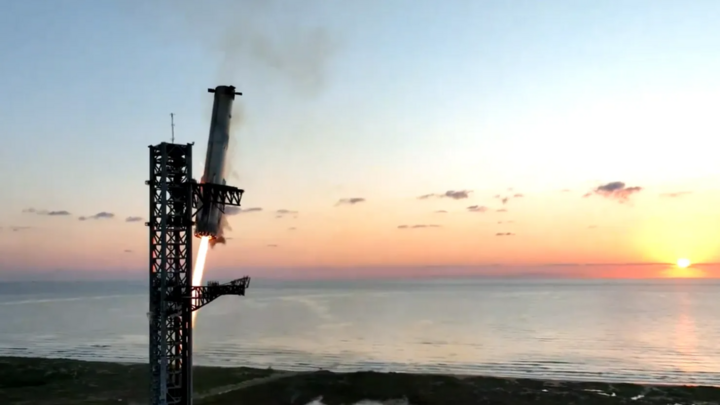The moment the Super Heavy booster stage was recaptured. (Video: SpaceX)
SpaceX launched its 400-foot-tall Starship rocket for the fifth time on October 13 from Starbase in South Texas at 8:25 a.m. ET, then captured the Super Heavy first stage after it successfully landed.
About seven minutes after liftoff, SpaceX's Super Heavy booster stage made a precise landing, hovering near the Mechazilla launch tower as the tower used its metal arms to hold it in place.
“ This is a historic day for engineering ,” said Kate Tice, SpaceX’s manager of Engineering Quality Systems, during live commentary as SpaceX employees cheered and cheered behind her at the Hawthorne, California, headquarters. “ This is crazy! On the first try, we successfully captured the Super Heavy booster back into the launch tower .”

The scene of the Mechazilla arm successfully capturing the Super Heavy booster. (Photo: SpaceX)
When the 71-meter-tall Super Heavy booster separated at an altitude of 65 kilometers above Earth, the rocket's upper stage continued to push to an altitude of nearly 145 kilometers, flying around the planet at a speed of 27,000 kilometers per hour before landing in the Indian Ocean as planned.
Before landing, the booster stage re-ignites three of its Raptor engines, slowing its descent and rotating toward the Mechazilla launch tower, where it is secured by mechanical arms, nicknamed "chopsticks".
SpaceX's successful test is part of its goal of developing a fully reusable rocket to transport humans, scientific equipment and cargo to the Moon and beyond to Mars.
SpaceX is developing Starship to help humanity colonize the Moon and Mars, among other exploration feats. The vehicle is designed to be fully and quickly reusable (as demonstrated by plans to land the Super Heavy booster on the launch pad, reducing the time needed between flights). This, combined with Starship’s unprecedented power, could revolutionize spaceflight, according to the company and Elon Musk.
NASA also has faith in the vehicle, having selected it to become the first manned lander in the Artemis lunar exploration program. If all goes according to plan, Starship will carry NASA astronauts to the Earth's natural satellite for the first time during the Artemis 3 mission, scheduled to launch in September 2026.
Why are reusable rockets important?
The cost of a rocket launch can vary widely depending on many factors, including the payload, destination, and type of rocket used. In recent times, the average cost of a launch has ranged from tens of millions to hundreds of millions of dollars.
SpaceX’s Falcon 9 rocket launches are advertised at around $62 million per launch, while larger rockets like the Falcon Heavy can cost more than $90 million per launch. On the higher end, NASA estimates the Space Launch System (SLS) could cost more than $2 billion per launch.

When reaching a certain altitude and speed, the spacecraft will separate the booster rocket to reduce weight and escape the Earth's gravity. (Illustration: SpaceX)
While space technology continues to advance, one of the biggest challenges today is reducing the cost of space flight. The amount of labor and materials needed to design, build, maintain, and test a rocket for a successful launch is very expensive.
Currently, spacecraft are launched by rocket boosters. Every time it reaches a certain altitude and speed, it will gradually disconnect the boosters and let them fall back to Earth when they run out of fuel and thrust, in order to reduce weight. These boosters of course cannot be reused, because the process of re-entry into the atmosphere has friction that creates a lot of heat, causing serious destruction.
Using the traditional method of building rockets for single-use missions adds to these costs, reduces launch frequency and scale, and creates waste. Think of a commercial airliner – if a new plane had to be built for every flight, air travel would be very expensive. Therefore, having reusable rockets would revolutionize economics and productivity.
Unlike traditional disposable rockets, reusable rockets, such as Starship, are designed to be recovered and launched multiple times.
These missiles use features such as:
Propellant landing: The first stage of the rocket returns to Earth under its own power and lands vertically, using its engines to slow its descent.
Modular design: Rocket components are designed to be easily disassembled and refurbished between flights.
Heat shield technology: Reusable rockets can use advanced heat shield materials to protect them during re-entry.
Advanced Manufacturing: Reusable rockets often use advanced manufacturing materials to ensure durability over multiple launches.
The economic benefits of reusable launch vehicles are significant. Using reusable rockets compared to traditional rockets can be up to 65% cheaper. This model promises to reduce the cost of missions such as satellite deployment, resupply missions to the International Space Station (ISS), and missions to the Moon or Mars.
In addition to saving money, reusable launch vehicles also contribute to a more sustainable approach to space exploration. Reducing the number of discarded rocket components would reduce space junk, a growing environmental problem.
Additionally, reusable rockets use less fuel than disposable rockets, making them better for the environment.
Source



![[Photo] Prime Minister Pham Minh Chinh receives Deputy Prime Minister of the Republic of Belarus Anatoly Sivak](https://vstatic.vietnam.vn/vietnam/resource/IMAGE/2025/4/2/79cdb685820a45868602e2fa576977a0)
![[Photo] Prime Minister Pham Minh Chinh receives CEO of Standard Chartered Group](https://vstatic.vietnam.vn/vietnam/resource/IMAGE/2025/4/2/125507ba412d4ebfb091fa7ddb936b3b)
![[Photo] General Secretary To Lam receives Russian Ambassador to Vietnam](https://vstatic.vietnam.vn/vietnam/resource/IMAGE/2025/4/2/b486192404d54058b15165174ea36c4e)





























































































Comment (0)